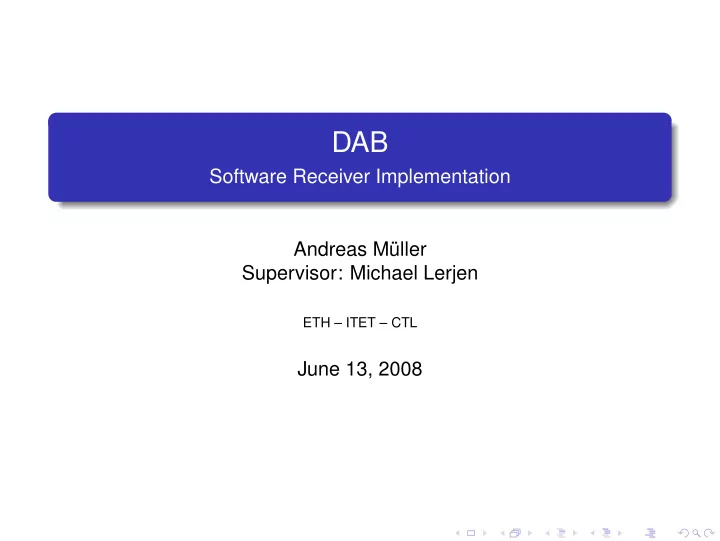

DAB Software Receiver Implementation Andreas M¨ uller Supervisor: Michael Lerjen ETH – ITET – CTL June 13, 2008
Introduction 1 Task Software Defined Radio DAB GNU Radio and USRP Implementation 2 OFDM Synchronisation OFDM Demodulation Evaluation 3 Test Setup Results Conclusions 4 Questions 5
Introduction Implementation Evaluation Conclusions Questions Introduction 1 Task Software Defined Radio DAB GNU Radio and USRP Implementation 2 Evaluation 3 Conclusions 4 Questions 5
Introduction Implementation Evaluation Conclusions Questions Task Goal: Implementation of a real-time DAB receiver as SDR SDR Software Defined Radio → (almost) all signal processing in software DAB Digital Audio Broadcasting → digital radio technology standardized by ETSI Real-time Process data as fast as it arrives → 2 MSPS or 16 MB/s
Introduction Implementation Evaluation Conclusions Questions Software Defined Radio Idea Digitize the signal and do all the signal processing in (high level, architecture independent) software. Strengths Flexibility Reusable code, fast development cycle Cognitive radio: Adapts itself dynamically to RF environment → better spectral and power efficiency Weaknesses Limited sample rate and dynamic range of ADCs and DACs → analog front end needed for filtering Resource usage, energy consumption, cost
Introduction Implementation Evaluation Conclusions Questions Digital Audio Broadcasting (DAB) Specification Modes Four modes for different frequency ranges and RF characteristics Presentation: Mode I (Code: All Modes) DAB Mode I OFDM signal Frames with 76 OFDM symbols (1 pilot, 75 data) Null symbols (energy zero) to separate frames 1536 subcarriers ` a 1 kHz & central carrier zero → 1.537 MHz D-QPSK modulation for each subcarrier Cyclic prefix: 504 samples → SFN with max. TX distance 74 km Upper Layers Punctured convolutional coding Energy dispersal, Time interleaving MPEG 2 audio coding
Introduction Implementation Evaluation Conclusions Questions GNU Radio Overview Open source framework for real-time software radios Provides many common building blocks: FFT, FIR & IIR filters, mathematical operations, AGC, modulation & demodulation, . . . Flow Graph Concept Programmer creates a directed graph for sample flow Signal processing blocks are written in C++ and wired together in Python Signal Processing Block work() function receives a number of samples from scheduler Block processes as many samples as possible and returns the number of consumed and produced samples
Introduction Implementation Evaluation Conclusions Questions Universal Software Radio Peripheral (USRP) Hardware Interface between computer and antenna is needed Most commonly used with GNU Radio: USRP USRP Two AD9862 Mixed Signal Front-End Processors 4 DACs with sampling rate 128 MSPS → 2 I/Q TX channels 4 ADCs with sampling rate 64 MSPS → 2 I/Q RX channels Altera Cyclone FPGA for conversion to/from baseband, decimation/interpolation, multiplexing and buffering Cypress FX2 USB 2.0 interface Daughterboards according to selected frequency range
(Source: http://ettus.com)
Introduction Implementation Evaluation Conclusions Questions Introduction 1 Implementation 2 OFDM Synchronisation OFDM Demodulation 3 Evaluation Conclusions 4 Questions 5
Introduction Implementation Evaluation Conclusions Questions OFDM I – Synchronisation Time Synchronisation Frame start detection must be accurate, as the other blocks depend on it Can easily be done by looking at the energy of the signal (Null symbols) Implemented with moving sum, inverter and peak detector Frequency Synchronisation Small subcarrier spacing → accurate synchronisation needed Fine frequency synchronisation (offsets < subcarrier spacing) compare cyclic prefix to end of the symbol → fine frequency offset can be estimated from the phase offset Coarse frequency synchronisation (offsets > subcarrier spacing) done after fine frequency synchronisation and after FFT simply shift signal in the frequency domain → very efficient
Introduction Implementation Evaluation Conclusions Questions OFDM II – Demodulation Demodulation Besides time and frequency synchronisation, demodulation is rather straightforward Sampler: Remove cyclic prefix, pack each OFDM symbol in a vector FFT Calculate phase difference (undo the D in D-QPSK) Magnitude equalization (only needed for soft bits, as the information is only in the phase) Undo frequency interleaving: Mix symbols according to sequence specified in DAB standard I and Q components contain independent bits → simply check if ℜ ( x ) > 0 and ℑ ( x ) > 0
Introduction Implementation Evaluation Conclusions Questions Introduction 1 Implementation 2 Evaluation 3 Test Setup Results Conclusions 4 Questions 5
Introduction Implementation Evaluation Conclusions Questions Test Setup Simulation Cycle Generate random bytes Modulation Channel-model distorts OFDM signal Demodulation Calculate BER from original and received bytes Channel Model Sampling frequency offset modeled by fractional interpolator Multipath propagation modeled with FIR filter Frequency offset (signal source + multiplication block) AWGN (noise source + adder block)
Introduction Implementation Evaluation Conclusions Questions Results – SNR
Introduction Implementation Evaluation Conclusions Questions Results – Effects of Multipath Propagation DAB Mode 1 2 3 4 Cyclic Prefix Length 504 126 63 252
Introduction Implementation Evaluation Conclusions Questions Introduction 1 Implementation 2 Evaluation 3 Conclusions 4 Questions 5
Introduction Implementation Evaluation Conclusions Questions Conclusions Conclusions Real-time processing is possible FIBs successfully decoded No audio yet Challenges Very efficient algorithms and programming needed Many signal processing papers are written from a primarily mathematical perspective Advantages Same code for simulation and actual receiver Open source code of existing blocks helps understand algorithms Existing code can sometimes be adapted for new purposes GNU Radio: Large and enthusiastic community
Introduction Implementation Evaluation Conclusions Questions Introduction 1 Implementation 2 Evaluation 3 Conclusions 4 Questions 5
Introduction Implementation Evaluation Conclusions Questions Questions? Thank you for your attention.
Recommend
More recommend